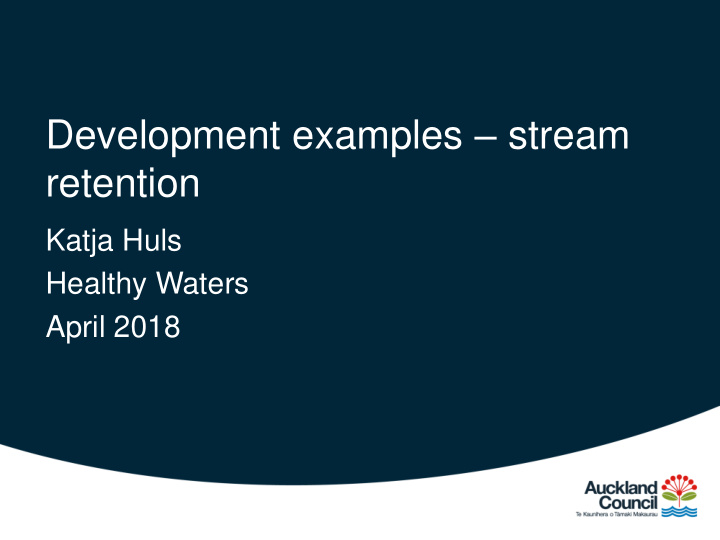



Development examples – stream retention Katja Huls Healthy Waters April 2018
Contents - Stream loss numbers - Auckland Unitary Plan rule - Special Housing Areas - Structure planning process - Development examples
Stream loss
Stream Loss Permanent Stream loss was on average in Auckland was: 10.5km per annum Long Term Plan KPI: 3.5km per annum In 2016 after partial implementation of the Auckland Unitary Plan: Permanent Streams Intermittent Streams Loss 1.4km Loss 1.4km Mitigation 3.6km Mitigation 237m Total gain 2.2km Total loss -1.2km Total loss: 2.8km Total mitigation: 3.8km
Auckland Unitary Plan Rule
Auckland Unitary Plan Objective Policy
Auckland Unitary Plan Rule Offsetting
Links to other stormwater drivers Flood resilience • Stream corridors provide for the conveyance of flood flows • Plan for 100 year event plus climate change and maximum probable development in the catchment • Major overland flow paths (ephemeral streams) must be retained if flows cannot be safely conveyed in the road corridor • Buildings cannot be located in the floodplain in greenfield development – a piped stream will still have a floodplain and is not developable land
Flooding and piped streams
Flood mitigation via stream daylighting Our department is currently implementing two large flood mitigation projects by: • Restoring a stream channel – Oakley Creek • Creating a stream channel – Takanini Cascades The projects provide amenity, connectivity and open space for adjacent dense development.
Links to other stormwater drivers Water quality Stream retention and restoration provides for much better water quality outcomes in freshwater and marine environments • NZ Coastal Policy Statement (2010) • maintain or enhance natural biological and physical processes/water quality • avoid / remedy cross contamination of sewage and stormwater systems • reduce contaminant and sediment loadings in stormwater at source • integrated management of catchments/networks • design options that reduce flows to stormwater networks • National Policy Statement Freshwater Management (2014/17) • maintain or improve overall water quality, improve where degraded • safeguard ecosystems and health of communities by managing use of land and discharges • seek to halt declining trends in ecosystem health (MCI) and enhance where degraded
Development examples
Special Housing Areas in Auckland • 26 plan changes • 154 SHAs – 63,000 dwellings • 23,000 in the Future Urban Zone • Three key growth areas in North, West and South Auckland
- Wainui - Kumeu/Huapai - Whenuapai - Scott Point - Redhills - Flat Bush
- Hingaia - Bremner Road - Wesley - Belmont
Wainui
Kumeu/Huapai
Kumeu/Huapai
Whenuapai
Whenuapai
Scott Point
Redhills
Crows Road
Flat Bush
Hingaia – Karaka Brookview & KARLA
Bremner Road
Wesley Headwater streams and wetlands protected by: • Retention and enhancement • Requiring infiltration of stormwater to provide baseflow via raingardens, tree pits and infiltration trenches • Original proposal provided 6 online dams. These were removed to protect stream habitat. Flood flows were allowed to pass forward instead, generating a very minor effect on downstream rural land
Belmont Stream channel retained and enhanced Stream daylit Flood mitigation within the green corridor Stormwater and open space integrated
Structure planning process
Structure planning process • “Hot tub” workshops with specialists from applicant and council teams • Apply Water Sensitive Design • Adjust density and housing typology • 300m2 sections typical • Terraced housing • Adjust road crossings to avoid multiple stream branches • Restore and enhance streams and wetlands • Apply ecological corridors where relevant
Development responses - Increase density adjacent to the stream - “Green Street” approach with stream adjacent to the road - Commercial area facing and integrating with streams - Pedestrian and cycling connectivity - Integration with flood attenuation - Stream daylighting - Integration of stormwater treatment and hydrology mitigation devices - Minimum 10m width planting either side
Recommend
More recommend